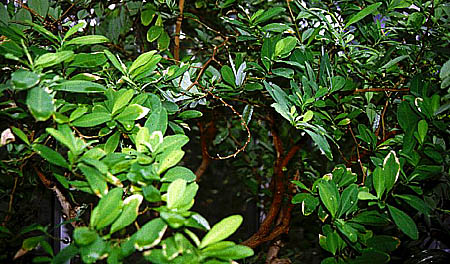Coca
Erythroxylon coca Believe it or not, in the 16th century, there really was a “Land of the drug addicts”, located in South America. At that time, the Incas undertook a great expansion and conquered many neighboring native tribes. |
The population was persuaded to work very hard, everybody regardless of gender or age worked all day to receive only a third of the production but there were no rebellions and no discontent. The unconditional obedience of the masses was due to chewing the leaves of coca, which made people the perfect workersâthey hardly ate or slept but felt satisfied, even happy. However, the narcotic also led to premature aging and a physical and mental breakdown. Then came an agonizing death.
Copyright
© Thomas Schöpke, http://www.plant-pictures.com |
The plant which caused, and unfortunately still causes, that degradation of personality is a two- to three-meter-high evergreen bush from the wet tropical regions of South America, nowadays also cultivated in subtropical zones and South Asia. It has small shiny spear-shaped leaves and red cherry-fruit. Until 1860, when the alkaloid cocaine was first extracted from the leaves of the plant, people did not know why coca had such a disastrous effect. The substance obtained was a white scentless powder, which particularly affects the sensibility of skin and the sensory organs. This property made it valuable for surgery and two decades later it was already in use. Cocaine also stimulates the central nervous system. Therefore, one loses oneâs feelings of fatigue and hunger, the inferiority complex and bad mood; however, oneâs health and will deteriorate. The poisoning is very pleasant at first owing to a momentary euphoria and incapability of perceiving the environment as it is. Soon after that, weakness occurs, the pulse accelerates and becomes irregular. Affected people may have seizures accompanied by breathing- and cardiac disruptions, which may lead to a preventable fatal end.There are many derivatives of cocaine such as novocaine and dicaine. Novocaine injections are generally used in a 1-10% saline solution for dental and spinal anesthesia. Unlike cocaine, procaine is non-addictive, yet toxic. Probably, the most toxic one of all derivatives is crack. It has wide application everywhere else but in medicine.
|
The extent of mental degradation caused by this insidious poison is much greater than that caused by many others. Its use leads to paranoia, audial hallucinations, extreme aggression and even inclination to suicide.The number of the cocaine- and crack-addicts is getting larger and larger; pregnant women take drugs and bear babies with monstrous abnormalities. Cocaine has been popular since the 16th century and is still a major threat to our generation.

